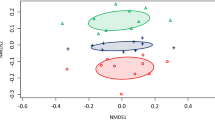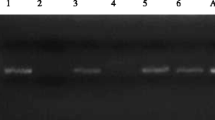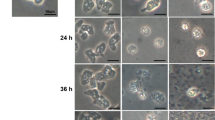Abstract
Exposure to viable Acanthamoeba may cause fatal encephalitis and blinding keratitis in humans. Quantification of environmental Acanthamoeba by a reliable analytical assay is essential to assess the risk of human exposure and efficacy of control measures (e.g., superheating). Two DNA binding dyes (ethidium monoazide (EMA) and propidium monoazide) coupled with real-time quantitative PCR (qPCR) were tested for the ability in selectively quantifying viable Acanthamoeba castellanii. This newly developed qPCR assay was applied to determine the density of environmental Acanthamoeba and disinfection efficacy of superheating. Results showed qPCR with 2.3 μg/mL EMA performed optimal with a great linearity (R 2 = 0.98) and a wide range of detection (5–1.5 × 105 cells). EMA-qPCR analyses on water samples collected from cooling towers, eyewash stations, irrigated farmlands, and various wastewater treatment stages further showed viable Acanthamoeba density from nondetectable level to 6.3 × 105 cells/L. Superheating A. castellanii at 75–95 °C for 20 min revealed significant reductions in both EMA-qPCR and qPCR detectable Acanthamoeba target sequences with an adverse association between heating temperature and qPCR-determined DNA quantity (r = −0.76 to −0.93, p < 0.0001). Moreover, A. castellanii trophozoites were more sensitive to superheat stress than the cells being encysted for 6 and 13 d (p < 0.05). This is the first study to quantify environmental Acanthamoeba and characterize their responses to superheating by EMA-qPCR. The quantitative data provided in this study facilitate to understand better the relative risk for human exposed to viable Acanthamoeba and the efficacy of superheating against Acanthamoeba.




Similar content being viewed by others
References
Andorra I, Esteve-Zarzoso B, Guillamon JM, Mas A (2010) Determination of viable wine yeast using DNA binding dyes and quantitative PCR. Int J Food Microbiol 144:257–262
Bagheri HR, Shafiei R, Shafiei F, Sajjadi SA (2010) Isolation of Acanthamoeba Spp. from drinking waters in several hospitals of Iran. Iran J Parasitol 5(2):19–25
Barker J, Brown MR, Collier PJ, Farrell I, Gilbert P (1992) Relationship between Legionella pneumophila and Acanthamoeba polyphaga: physiological status and susceptibility to chemical inactivation. Appl Environ Microbiol 58:2420–2425
Barker J, Scaife H, Brown MR (1995) Intraphagocytic growth induces an antibiotic-resistant phenotype of Legionella pneumophila. Antimicrob Agents Chemother 39:2684–2688
Behets J, Declerck P, Delaedt Y, Verelst L, Ollevier F (2007) Survey for the presence of specific free-living amoebae in cooling waters from Belgian power plants. Parasitol Res 100:1249–1256
Berk SG, Ting RS, Turner GW, Ashburn RJ (1998) Production of respirable vesicles containing live Legionella pneumophila cells by two Acanthamoeba spp. Appl Environ Microbiol 64:279–286
Berrada H, Soriano JM, Manes YPJ (2006) Quantification of Listeria monocytogenes in salads by real time quantitative PCR. Int J Food Microbiol 107:202–206
Bowers B, Korn ED (1969) The fine structure of Acanthamoeba castellanii (Neff strain). II. Encystment. J Cell Biol 41:786–805
Brescia CC, Griffin SM, Ware MW, Varughese EA, Egorov AI, Villegas EN (2009) Cryptosporidium propidium monoazide-PCR, a molecular biology-based technique for genotyping of viable Cryptosporidium oocysts. Appl Environ Microbiol 75:6856–6863
Cawthorn DM, Witthuhn RC (2008) Selective PCR detection of viable Enterobacter sakazakii cells utilizing propidium monoazide or ethidium bromide monoazide. J Appl Microbiol 105:1178–1185
Chang CW, Wu YC, Ming KW (2010) Evaluation of real-time PCR methods for quantification of Acanthamoeba in anthropogenic water and biofilms. J Appl Microbiol 109:799–807
Chang CW, Wu YC (2010) Evaluation of DNA extraction methods and dilution treatment for detection and quantification of Acanthamoeba in water and biofilm by real-time PCR. Water Sci Technol 62(9):2141–2149
Chang CW, Chou FC (2011a) Assessment of bioaerosol sampling techniques for viable Legionella pneumophila by ethidium monoazide quantitative PCR. Aerosol Sci Technol 45:343–351
Chang CW, Chou FC (2011b) Methodologies for quantifying culturable, viable and total Legionella pneumophila in indoor air. Indoor Air 21:291–299
Chang CW, Hung PY (2012a) Methods for detection and quantification of airborne legionellae around cooling towers. Aerosol Sci Technol 46:369–379
Chang CW, Hung PY (2012b) Evaluation of sampling techniques for detection and quantification of airborne legionellae at biological aeration basins and shower rooms. J Aerosol Sci 48:63–74
Chavez-Munguia B, Omana-Molina M, Gonzalez-Lazaro M, Gonzalez-Robles A, Bonilla P, Martinez-Palomo A (2005) Ultrastructural study of encystation and excystation in Acanthamoeba castellanii. J Eukaryot Microbiol 52:153–158
Chen NT, Chang CW (2010) Rapid quantification of viable Legionella in water and biofilm using ethidium monoazide coupled with real-time quantitative PCR. J Appl Microbiol 109:623–634
Coulon C, Collignon A, McDonnell G, Thomas V (2010) Resistance of Acanthamoeba cysts to disinfection treatments used in health care settings. J Clin Microbiol 48:2689–2697
Cirillo JD, Cirillo SL, Yan L, Bermudez LE, Falkow S, Tompkins LS (1999) Intracellular growth in Acanthamoeba castellanii affects monocyte entry mechanisms and enhances virulence of Legionella pneumophila. Infect Immun 67:4427–4434
Fields BS, Sanden GN, Barbaree JM, Morrill WE, Wadowsky RM, Whites EH, Feeley JC (1989) Intracellular multiplication of Legionella pneumophila in amoebae isolated from hospital hot water tanks. Curr Microbiol 18:131–137
Fittipaldi M, Rodriguez NJP, Adrados B, Agusti G, Penuela G, Morato J, Codony F (2011) Discrimination of viable Acanthamoeba castellanii trophozoites and cysts by propidium monoazide real-time polymerase chain reaction. J Eukaryot Microbiol 58:359–364
Greub G, Raoult D (2004) Microorganisms resistant to free-living amoebae. Clin Microbiol Rev 17:413–433
Heaselgrave W, Patel N, Kilvington S, Kehoe SC, McGuigan KG (2006) Solar disinfection of poliovirus and Acanthamoeba polyphaga cysts in water—a laboratory study using simtilated sunlight. Lett Appl Microbiol 43:125–130
Kao PM, Tung MC, Hsu BM, Tsai HL, She CY, Shen SM, Huang WC (2013) Real-time PCR method for the detection and quantification of Acanthamoeba species in various types of water samples. Parasitol Res 112:1131–1136
Khan NA (2006) Acanthamoeba: biology and increasing importance in human health. FEMS Microbiol Rev 30:564–595
Kilvington S (1990) Activity of water biocide chemicals and contact lens disinfectants on pathogenic free-living amoebae. Int Biodeterior 26:127–138
Lee JL, Levin RE (2008) Discrimination of gamma-irradiated and nonirradiated Vibrio vulnificus by using real-time polymerase chain reaction. J Appl Microbiol 104:728–734
Lee JL, Levin RE (2009) A comparative study of the ability of EMA and PMA to distinguish viable from heat killed mixed bacterial flora from fish fillets. J Microbiol Methods 76:93–96
Li CS, Chia WC, Chen PS (2007) Fluorochrome and flow cytometry to monitor microorganisms in treated hospital wastewater. J Environ Sci Health Part A 42:195–203
Lorenzo-Morales J, Ortega-Rivas A, Foronda P, Martinez E, Valladares B (2005) Isolation and identification of pathogenic Acanthamoeba strains in Tenerife, Canary Islands, Spain from water sources. Parasitol Res 95:273–277
Luo LX, Walters C, Bolkan H, Liu XL, Li JQ (2008) Quantification of viable cells of Clavibacter michiganensis subsp. michiganensis using a DNA binding dye and a real-time PCR assay. Plant Pathol 57:6
Magnet A, Galvan AL, Fenoy S, Izquierdo F, Rueda C, Vadillo CF, Perez-Irezabal J, Bandyopadhyay K, Visvesvara GS, da Silva AJ, del Aguila C (2012) Molecular characterization of Acanthamoeba isolated in water treatment plants and comparison with clinical isolates. Parasitol Res 111:383–392
Mahmoudi MR, Taghipour N, Eftekhar M, Haghighi A, Karanis P (2012) Isolation of Acanthamoeba species in surface waters of Gilan province-north of Iran. Parasitol Res 110:473–477
Mohapatra BR, La Duc MT (2012) Rapid detection of viable Bacillus pumilus SAFR-032 encapsulated spores using novel propidium monoazide-linked fluorescence in situ hybridization. J Microbiol Methods 90(1):15–19
Nam S, Kwon S, Kim MJ, Chae JC, Maeng PJ, Park JG, Lee GC (2011) Selective detection of viable Helicobacter pylori using ethidium monoazide or propidium monoazide in combination with real-time polymerase chain reaction. Microbiol Immunol 55:841–846
Novak JS, Sommers CH, Juneja VK (2005) A convenient method to detect potentially lethal heat-induced damage to DNA in Clostridium perfringens. Food Control 16:399–404
Page FC (1988) A new key to freshwater and soil Gymnamoebae. Freshwater Biological Association, Ambleside, UK
Pagnier I, Merchat M, La Scola B (2009) Potentially pathogenic amoeba-associated microorganisms in cooling towers and their control. Future Microbiol 4:615–629
Pan Y, Breidt F (2007) Enumeration of viable Listeria monocytogenes cells by real-time PCR with propidium monoazide and ethidium monoazide in the presence of dead cells. Appl Environ Microbiol 73:8028–8031
Paszko-Kolva C, Sawyer T, Palmer C, Nerad T, Fayer R (1998) Examination of microbial contaminants of emergency showers and eyewash station. J Ind Microbiol Biotechnol 20:139–143
Qvarnstrom Y, Visvesvara GS, Sriram R, da Silva AJ (2006) Multiplex real-time PCR assay for simultaneous detection of Acanthamoeba spp., Balamuthia mandrillaris, and Naegleria fowleri. J Clin Microbiol 44:3589–3595
Riviere D, Szczebara FM, Berjeaud JM, Frere J, Hechard Y (2006) Development of a real-time PCR assay for quantification of Acanthamoeba trophozoites and cysts. J Microbiol Methods 64:78–83
Rodriguez-Zaragoza S (1994) Ecology of free-living amoebae. Crit Rev Microbiol 20:225–241
Sheng WH, Hung CC, Huang HH, Liang SY, Cheng YJ, Ji DD, Chang SC (2009) Case report: first case of granulomatous amebic encephalitis caused by Acanthamoeba castellanii in Taiwan. AmJTrop Med Hyg 81:277–279
Stockman LJ, Wright CJ, Visvesvara GS, Fields BS, Beach MJ (2011) Prevalence of Acanthamoeba spp. and other free-living amoebae in household water, Ohio, USA—1990–1992. Parasitol Res 108:621–627
Turner NA, Russell AD, Furr JR, Lloyd D (2000) Emergence of resistance to biocides during differentiation of Acanthamoeba castellanii. J Antimicrob Chemother 46:27–34
Acknowledgment
This study was supported, in part, by grants from the National Science Council, Taiwan.
Author information
Authors and Affiliations
Corresponding author
Rights and permissions
About this article
Cite this article
Chang, CW., Lu, LW., Kuo, CL. et al. Density of environmental Acanthamoeba and their responses to superheating disinfection. Parasitol Res 112, 3687–3696 (2013). https://doi.org/10.1007/s00436-013-3556-3
Received:
Accepted:
Published:
Issue Date:
DOI: https://doi.org/10.1007/s00436-013-3556-3




